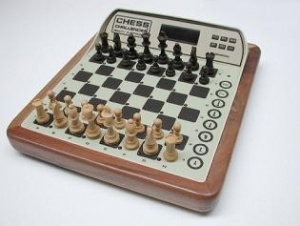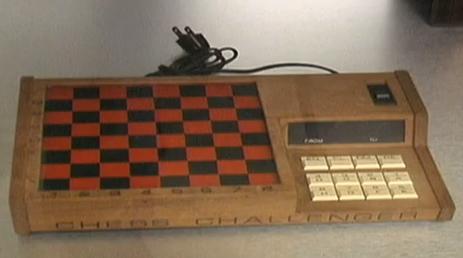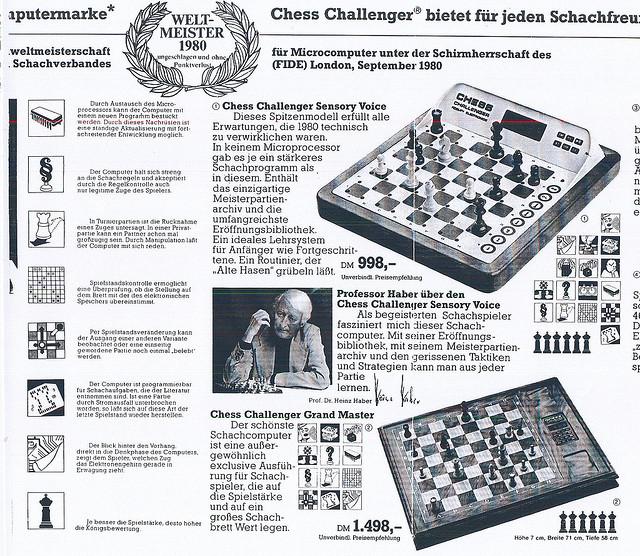Chess Challenger
Home * Engines * Chess Challenger
Chess Challenger, or Fidelity Chess Challenger,
was a series of dedicated chess computers produced and market by Fidelity Electronics. The Chess Challenger 1 was the first commercial chess computer of its kind in 1976, invented by Sidney Samole, with a program by Ron Nelson, developed for an Altair 8800 Microcomputer with an Intel 8080 CPU. Further versions of Nelson's program run on a more advanced Z80 CPU, great commercial success was the Chess Challenger 7 [2] in 1979. Ed English, an early game programmer affiliated with Fidelity Electronics in 1979/80, improved the alpha-beta implementation to double the playing speed [3].
Contents
Photos
Chess Challenger Prototype, 1976, 8080 [4] .
Sargon becomes Challenger
In 1980, when Dan and Kathe Spracklen started to collaborate with Samole, a 6502 Version of Chess Challenger was built for a Sargon III port. The 6502 was better suited for Sargon than Z80. Excerpt from their oral history how it went with Fidelity [5] :
So, that’s about the time we started looking at Fidelity again. We got in contact with Sid Samole, who was the President of the company, and he said, “Well, come out and see us and bring your- what you got out there and show it to us.” And so we got on a plane and flew out to Miami, and showed off our program to him. And they had their chief engineer, Ron Nelson, look at it, and they were impressed. And so they offered us a big contract, basically, to go to work for them, basically, fulltime. And we didn’t have to go to Miami. We could stay in San Diego.
They had the Chess Challenger 1, I think, out at the time, or 2, and they were looking for something better. Our program, that we brought with us, just shellacked their program. We had a little tournament there, in Miami, just a little, between us, on our- the one we brought with us. And they were impressed.
And we continued to sell both through, or Sargon, through Hayden. So Fidelity didn’t mind that. The said that’s cool. They didn’t see it as a competition with them.
WMCCC 1980, MCC 1980
The immediate success was the lucky win of the 1st World Microcomputer Chess Championship, September 4 to 9, 1980, in London. Chess Challenger with a 6502 CPU, notably winning last three of five rounds against three of four other Sargon incarnations! While the ICGA tournament site states a Z80A CPU [6], Kevin O’Connell reported the World Microcomputer Chess Champion was equipped with a MOS Technology processor, despite newest Fidelity computers were shipped with Z80/Z80A [7]. As further confirmed by Fidelity Electronics' Vice President Myron Samole in an Personal Computing interview, the Champion Sensory Challenger, which also won the MCC 1980 at September 5 to 7 in San Jose, California had a program written around the 6502 chip [8].
German Chess Challenger brochure with Prof. Heinz Haber endorsement [9]
Chess Challenger Sensory Voice [10], a Z80 based Nelson Program as Micro Champ? [11]
WCCC 1980
The Chess Challenger which played the WCCC 1980 end of September in Linz and finished last was presumably an older Z80 based computer with a Nelson program [12]. Fidelity's flagship end of the 70s, with World Champion 1980 advertisement was the Chess Challenger Sensory Voice. The first 6502 based computer with a Spracklen program commercially available appeared in 1981 as Champion Sensory Chess Challenger [13] .
ACM 1980
The strong third place at the ACM 1980 in October was again a great success, only losing to Belle in the last round [14]. Description given from the ACM booklet with mentioned authors Dan and Kathe Spracklen, Ronald Nelson, Frank Duason [15]
This marks the first appearance in an ACM tournament for this popular machine. Chess Challenger is written in assembly language for a 6502 microprocessor. It has 20k bytes of memory and executes about 1,000,000 inst/sec. A book of about 1,000 moves is used. The program uses the alpha-beta algorithm with iterative deepening.
Name Confusion
Using the same name at almost the same time for programs with different authors and CPU architectures caused some confusion by potential customers, not to mention tournament organizers. Accordant to their product lineup and nomination, and caused by former tournament rules, permitting multiple, but different named entries from the same author, and commercial availability of participating computers, Fidelity Electronics somehow was "forced" to continue the naming obfuscation in further tournaments, where Fidelity computers with Spracklen programs participated as Fidelity X, Challenger-X, Elegance, Elite, Private Line, and Sensory.
Chess Challenger X
ACM 1986
In 1986, at the 17th ACM North American Computer Chess Championship, Fidelity showed up with a huge experimental, parallel machine, named Chess Challenger X. Authors were Ron Nelson, Dan Spracklen, Kathe Spracklen, and Danny Kopec as Book author. It had a Z80 controller, and 16 or more 68000 16-bit processors. The controller was written in C, the 16 or more Spracklen programs in assembler [16].
Chess Challenger X scored 50%, losing from Recom and Belle. Notably, in the same tournament, another Fidelity computer programmed by the Spracklens with a Kopec book took part, as Fidelity Experimental with a 68020 processor. It did not score better in that strong field and finally placed 10th.
ACM 1988
At the ACM 1988, the new experimental version of a 68030 based micro called Chess Challenger X showed a remarkable performance. Mentioned authors from the tournament report by Monty Newborn and Danny Kopec [17] were Dan and Kathe Spracklen as well as Ron Nelson. The 32-bit program, written in 68030 assembly language, drew Deep Thought and won versus Waycool, the current World Champion Cray Blitz, and HiTech. Chess Challenger X was likely the forerunner of the commercial available Fidelity Elite Avant Garde V9 [18] . One year later, at the WCCC 1989 in Edmonton, a similar machine, presumably with a further developed program, played under the name Fidelity X and finished sixth.
CC Clones
See also
- Fidelity
- Fidelity Electronics
- Ron Nelson
- Sidney Samole
- Dan Spracklen
- Kathe Spracklen
- Spracklens with Apple II ICE
Publications
1978 ...
- Editor (1978). Black-box war. Personal Computing, Vol. 2, No. 11, pp. 17, November 1978 » Boris
- Don Gerue, Russ McNeil (1979). Chess Challenger-10 wins Microchess Tourney. Personal Computing, Vol. 3, No. 2, pp. 63 » The Penrod Memorial Microchess Tournament
- John Larkins (1979). Inside Chess Challenger. Personal Computing, Vol. 3, No. 11, pp. 78
- Editor (1979). Misadvantages of a Chess Traveler. Personal Computing, Vol. 3, No. 12, pp. 75
1980 ...
- Sidney Samole (1980). Genius Offspring. Changing Times, refers Personal Computing, February 1979
- Evan Katz (1980). Chess Challenger's Voice comes out of Both Sides of its Mouth. Personal Computing, Vol. 4, No. 5, pp. 80
- Harry Shershow (1981). The MyChess-CSC Confrontation at San Jose. Personal Computing, Vol. 5, No. 1, pp. 79 » MCC 1980, Interviews with David Kittinger and Mike Samole
- John F. White (1981). Survey-Chess Games. Your Computer, August/September 1981
- John F. White (1982). Review-Morphy V Champion. Your Computer, January 1982
- John F. White (1982). Review-Chess Computers. Your Computer, March 1982
2000 ...
- Rob van Son (2002). De schaakcomputer daagt u uit!. Computerschaak, pdf hosted by Hein Veldhuis (Dutch)
Forum Posts
1998 ...
- Re: Old chess challenger 7 algorithms by Fernando Villegas, CCC, April 06, 1998
- Something More About Chess Challenger 7 by Fernando Villegas, CCC, April 06, 1998
- Fidelity Sensory Chess Challenger 8 by Jim Phillips, CCC, September 20, 1998
- Fidelity Chess Challenger 7 by Joseph R. Coppola, CCC, January 21, 1999
2000 ...
- Instruction Book For Fidelity Chess Challenger by John Burton, CCC, February 22, 2000
- What was Chess Challenger 7 thinking? by Rich Van Gaasbeck, CCC, March 06, 2002
- I Think I have Chess Challenger 7 search depths correctly now by Rich Van Gaasbeck, CCC, March 08, 2002
- Fidelity Sensory Chess Challenger 8 by Eric Guttenberg, CCC, February 20, 2005
- Chess Champion Sensory Challenger Asked by Fernando Villegas, CCC, March 06, 2006
2010 ...
- Fidelity World Champion Challenger by Larry, Hiarcs Forum, December 03, 2013
- Ron Nelsons dedicated chess computers by mclane, Hiarcs Forum, April 26, 2015
- Re: Ron Nelson by ChessChallenger, Hiarcs Forum, December 29, 2015
- Re: Ron Nelson by Chessmaster Ireland, Hiarcs Forum, January 02, 2016
- Re: Ron Nelson Chess Challenger 10 by ChessChallenger, Hiarcs Forum, January 24, 2016
- Re: Ron Nelson maybe will come here... by Ron Nelson, CCC, February 03, 2016
- Fidelity Chess Challenger 3 Components by ChessChallenger, Hiarcs Forum, February 03, 2016
External Links
- Challenger's ICGA Tournaments
- Fidelity Electronics from chesscomputers.org
- Fidelity Champion Sensory Challenger Electronic Chess Computer from The Spacious Mind
- Fidelity Chess Challenger 1 from Adam's Computer Chess Pages, May 30, 2012
- Fidelity from Schachcomputer.info Wiki (German)
- Sargon immer noch Marktführer:: Mikros noch ohne Großmeister-Format, Computerwoche, November 28, 1980 (German) » WCCC 1980, WMCCC 1980
Chess Challenger Voices
hosted by Tom Luif
Editions
References
- ↑ Sensory Chess Challenger, 1982 from The Computer History Museum
- ↑ Chess Challenger 7 from Schachcomputer.info Wiki (German)
- ↑ Ed English | LinkedIn
- ↑ Chess Challenger Prototype from World Chess Hall of Fame and Sidney Samole Chess Museum, see Sidney Samole and Fidelity Electronics from chesscomputers.org
- ↑ Gardner Hendrie (2005). Oral History of Kathe and Dan Spracklen. pdf from The Computer History Museum
- ↑ 1st World Microcomputer Chess Championship - ICGA Tournaments
- ↑ Kevin O’Connell (1980). World Microcomputer Chess Championship. Personal Computer World, November 1980
- ↑ Harry Shershow (1981). The MyChess-CSC Confrontation at San Jose. Personal Computing, Vol. 5, No. 1, pp. 79-81
- ↑ Grand Master Voice 1980 Brochure | Flickr - Fotosharing by Chewbanta
- ↑ Fidelity Chess Challenger Voice from Schachcomputer.info Wiki (German)
- ↑ Fidelity CC Sencory Voice was a Z80 based Nelson program, and not the 6502 based Spracklen program which won the WMCCC 1980
- ↑ Sargon immer noch Marktführer:: Mikros noch ohne Großmeister-Format, Computerwoche, November 28, 1980 (German)
- ↑ Fidelity CC Champion from Schachcomputer.info Wiki (German)
- ↑ "Belle" wurde auch US-Champion 1980: Frecher Schachzwerg beweist Kaltblütigkeit, January 23, 1981, Computerwoche 3/1981 (German)
- ↑ The Eleventh ACM's North American Computer Chess Championship, pdf from The Computer History Museum
- ↑ The ACM's Seventeenth North American Computer Chess Championship and The Sixth World Microcomputer Chess Championship from The Computer History Museum, pdf
- ↑ Monty Newborn and Danny Kopec (1989). Results of The Nineteenth ACM North American Computer Chess Championship, in The Twentieth ACM North American Computer Chess Championship from The Computer History Museum, pdf
- ↑ Fidelity Elite Avant Garde V9 from Schachcomputer.info Wiki (German)
- ↑ Fidelity from Schachcomputer.info Wiki (German)
- ↑ Chess Computer UK by Mike Watters


